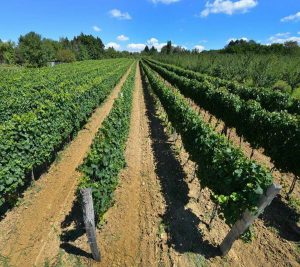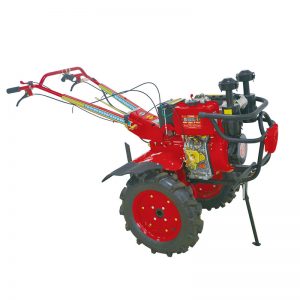Introduction
If you have a garden or a farm, you know how important it is to till the soil before planting. A power tiller can make this task easier and quicker, but it can be intimidating if you’ve never used one before. In this beginner’s guide, we will go over the basics of how to use a power tiller, including safety precautions, preparation, operation, and maintenance.
What is a Power Tiller?
A power tiller, also known as a rototiller. It is a gardening tool that uses rotating blades or tines to break up and aerate the soil. The tines can also be used to mix in compost or other organic materials to improve the soil’s quality. Power tiller has the characteristics of lightweight, small size, and simple structure. it is widely used in dry land, paddy fields, orchards in plains, mountains, and hills. With corresponding tools attached to it, it can be used for pumping water, generating electricity, spraying pesticides and sprinkling irrigation. It can also tow trailers for short-distance transportation. Tillers can move freely in the field which makes it easy for users to operate and store without the trouble of large-scale agricultural machinery unable to enter mountainous areas. Therefore, it is the best choice for farmers as an alternative to traditional ox-plowing.
Types of Power Tillers
There are two main types of power tillers: rear-tine and front-tine.
Rear-tine Tillers
Rear-tine tillers are designed for larger gardens or fields and have their tines located behind the engine. They are self-propelled and can be either counter-rotating or forward-rotating. Counter-rotating tillers are better suited for compacted soil, while forward-rotating tillers are better for softer soil.
Front-tine Tillers
Front-tine tillers are more compact and have their tines located in front of the engine. They are ideal for smaller gardens and are less powerful than rear-tine tillers.
Choosing the Right Tiller
When choosing a power tiller, consider the size of your garden or field and the type of soil you’ll be tilling. Rear-tine tillers are better for larger areas or compacted soil, while front-tine tillers are better for smaller areas and softer soil.

The application of power tillers
Safety Precautions
Before using a power tiller, it’s important to take safety precautions to prevent accidents and injuries. Here are some safety tips to keep in mind:
Step 1: Wear protective gear such as gloves, safety goggles, and sturdy shoes.
Step 2: Make sure the area is clear of debris, rocks, and other obstacles.
Step 3: Never wear loose clothing or jewelry that can get caught in the tiller’s moving parts.
Step 4: Do not start the tiller indoors or in an enclosed area with poor ventilation.
Step 5: Keep children and pets away from the area.
Preparation
Before using the power tiller, you need to prepare the area and the equipment. Here are the steps you should follow:
a. Choose a day when the soil is dry enough to be tilled but not too dry or hard.
b. Remove any large rocks, debris, or weeds from the area to be tilled.
c. For most gardens, adjust the tiller’s tines to the desired depth, usually between 4 to 6 inches.
d. Check the tiller’s engine’s oil, air filter, and fuel level.
e. Start the engine and let it warm up for a few minutes before using the tiller.
Operation
Once you’ve prepared the area and the equipment, it’s time to start using the power tiller. Here are the steps to follow:
Step 1: Start the engine and engage the tines.
Step 2: Hold the handles firmly and walk slowly behind the tiller as it moves forward.
Step 3: Tilt the tiller slightly upward to avoid digging too deep or damaging the soil.
Step 4: Turn the tiller at the end of each row by pulling the handlebars toward you.
Step 5: Continue tilling in rows until the entire area is tilled.
Entretien
Proper maintenance of the power tiller is essential to keep it working efficiently and to prevent breakdowns. Here are some tips for maintaining your tiller:
a. Clean the tiller after each use, removing any dirt or debris from the engine and tines.
b. Check the oil level, air filter, and spark plug regularly and replace them as needed.
c. Sharpen the tines if they become dull or damaged.
d. Store the tiller in a dry, covered area when not in use.
e. Have the tiller serviced by a professional if you notice any problems or issues.
Conclusion
Using a power tiller can make tilling your garden or farm easier and quicker, but it’s important to follow safety precautions, prepare the area and equipment properly, and maintain the tiller regularly. With these tips and some practice, you can become proficient at using a power tiller and enjoy a bountiful harvest.
Faq
Do I need a special license or certification to use a power tiller?
No, you do not need a license or certification to use a power tiller. However, you should follow safety precautions and read the instruction manual carefully before using the tiller.
How deep should I till my soil?
The depth at which you should till your soil depends on the type of crop you are planting and the soil conditions. In general, most garden crops need a depth of about 6 to 8 inches (15-20 cm) for optimal growth.
However, for some crops, such as carrots, which have long roots, you may need to till deeper to loosen the soil and create a better environment for root growth. On the other hand, for shallow-rooted crops such as lettuce or spinach, tilling to a depth of 4-5 inches (10-12 cm) may be sufficient.
It’s important not to till too deeply, as this can disrupt the soil structure and lead to compaction and poor drainage. In addition, tilling too deeply can bring up weed seeds from deeper layers of soil, leading to more weed problems.
Before tilling, it’s a good idea to test your soil to determine its texture and structure, as well as its nutrient levels. This can help you determine the best depth and technique for tilling your soil.
Can I use a power tiller for a large farm?
Yes, a power tiller can be used for a large farm, but the effectiveness of the tiller will depend on the size of the farm and the type of soil being tilled. Power tillers are best suited for smaller farms or garden plots, typically less than one acre in size, and for soil that is relatively loose and free of rocks and debris.
For larger farms, a larger and more powerful tiller, such as a tractor-mounted tiller, may be more appropriate. These larger tillers are capable of covering more ground and can work in tougher soil conditions, but they also require more power and may not be as maneuverable as smaller power tillers.

